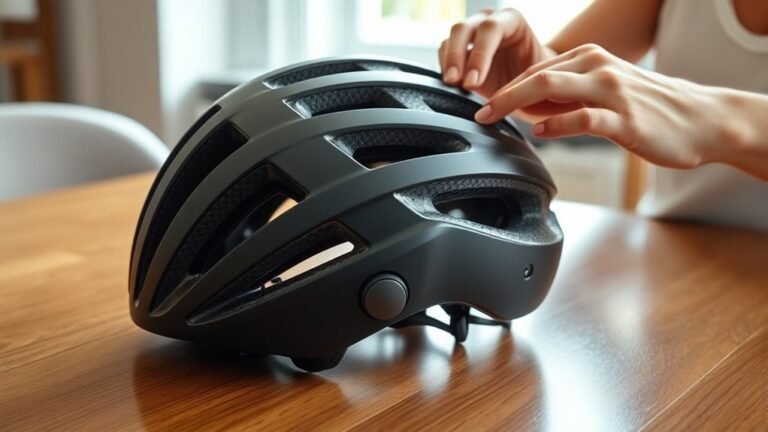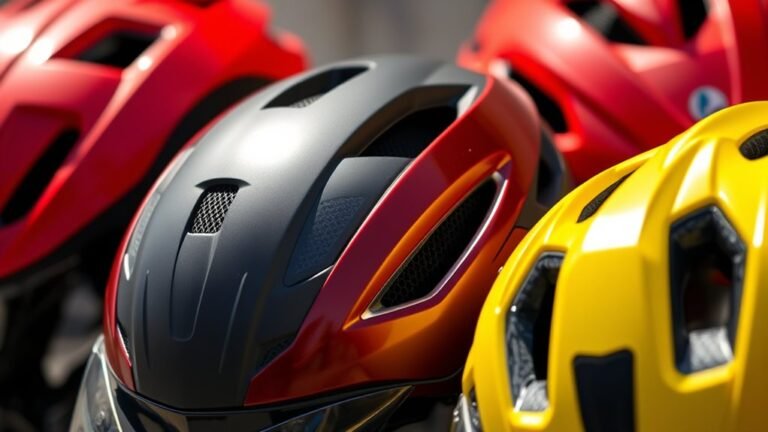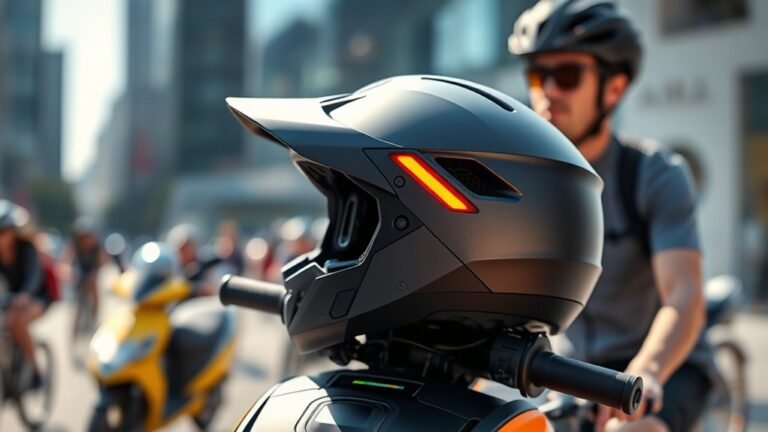The Science Behind Crash Protection for E-Bike Helmets
E-bike helmets are designed to manage impact forces through advanced materials and structural innovations. High-density EPS and superior EPP foams absorb energy, reducing the force transmitted to your head during a crash. The outer shells, often made from polycarbonate or fiberglass, enhance durability while maintaining comfort. Innovative features like smart ventilation and adjustable straps contribute to rider safety and fit. Understanding these elements is essential, and there’s more to explore about optimizing your protection on the road.
Understanding Impact Forces and Head Protection
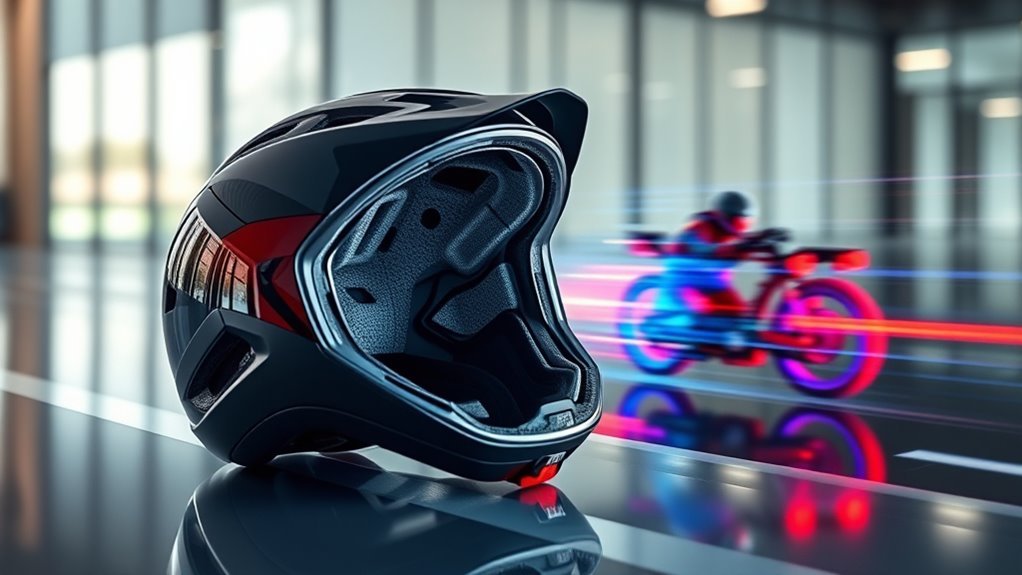
In the domain of e-bike safety, understanding impact forces and head protection is essential for riders. When you ride, impact dynamics play a significant role in how your helmet will perform during a crash. The helmet must effectively manage and distribute forces to minimize injury. This force distribution is critical; a well-designed helmet absorbs energy during an impact, reducing the force transmitted to your head. Analyzing how these forces interact can help you appreciate the importance of helmet design. The materials and structure must work together to mitigate the effects of a collision. By grasping these concepts, you empower yourself to make informed choices about your safety gear, ultimately enhancing your freedom while riding.
Materials Used in E-Bike Helmets

Choosing the right materials for e-bike helmets is essential for ensuring ideal safety and comfort. The interplay of foam technology and shell materials greatly influences your helmet’s performance. High-density EPS foam absorbs impact forces effectively, reducing the risk of head injuries during collisions. Some helmets integrate expanded polypropylene (EPP) foam, which offers superior resilience and multiple impact protection.
On the exterior, polycarbonate and fiberglass are popular shell materials, providing durability and structural integrity. These lightweight options not only enhance your helmet’s protection but also contribute to comfort during long rides. A well-constructed helmet balances these materials, ensuring you feel free and secure while steering through urban landscapes or venturing off the beaten path, ultimately enhancing your riding experience.
Innovative Design Features for Enhanced Safety
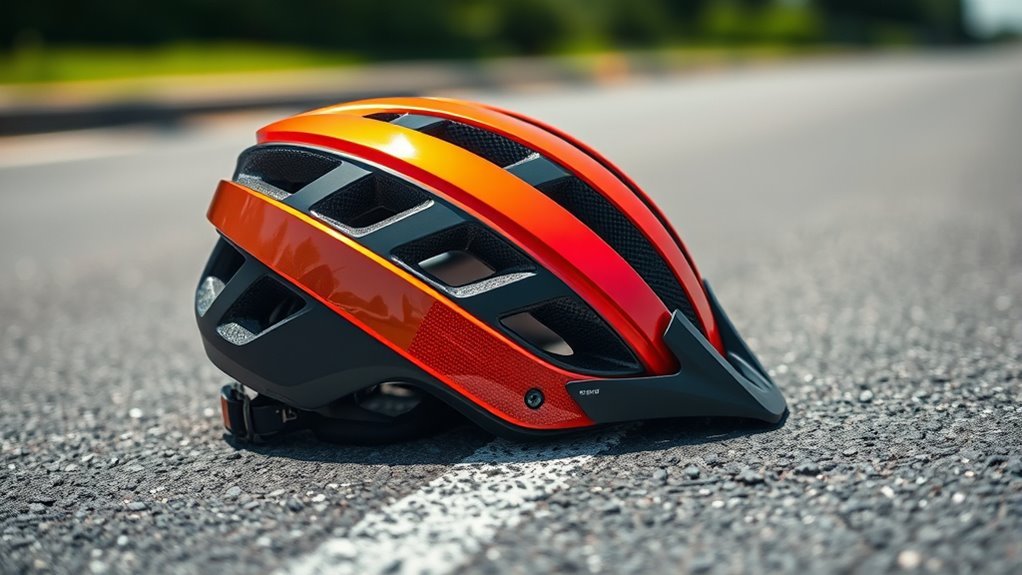
While you may prioritize materials when selecting an e-bike helmet, innovative design features play a crucial role in enhancing safety. Features like smart ventilation systems guarantee airflow, keeping you cool on long rides while maintaining focus. Reflective materials integrated into the design increase visibility, especially during low-light conditions, allowing you to ride with confidence.
| Feature | Benefit |
|---|---|
| Smart Ventilation | Enhances comfort and focus |
| Reflective Materials | Increases visibility |
| Adjustable Straps | Guarantees a secure fit |
| Aerodynamic Shape | Reduces wind resistance |
Testing Standards and Certification Processes
When selecting an e-bike helmet, understanding the testing standards and certification processes is essential for guaranteeing maximum safety. Various testing organizations, such as the Consumer Product Safety Commission (CPSC) and the European Committee for Standardization (CEN), establish rigorous certification requirements that helmets must meet. These standards evaluate impact resistance, penetration, and retention system performance to guarantee reliable protection during crashes. You should look for helmets that display compliance with these certifications, as they indicate thorough testing against potential hazards. Additionally, awareness of evolving standards helps you stay informed on advancements in safety technology. Adhering to these certification requirements not only enhances your freedom to ride but also reinforces your confidence in your helmet’s protective capabilities.
Choosing the Right Helmet for E-Biking
Understanding testing standards and certifications is only the first step in selecting the right helmet for e-biking. You must also consider helmet sizing and fit, as a proper fit is vital for safety and comfort. Measure your head circumference and refer to manufacturer sizing charts to find your size. It’s essential that the helmet sits snugly without being restrictive; it should not shift during movement. Look for features like adjustable straps and padded liners to enhance the fit. Additionally, consider the helmet’s weight and ventilation, which can impact long rides. Prioritize models specifically designed for e-biking, as they often incorporate enhanced protection features for higher speeds. Your freedom on the road depends on a well-fitted, reliable helmet.
Frequently Asked Questions
How Often Should I Replace My E-Bike Helmet?
You should replace your e-bike helmet every three to five years, even if it hasn’t been involved in a crash. Helmets degrade over time due to factors like UV exposure and general wear. Regular helmet maintenance is vital; inspect it for cracks or other damage. If you experience an impact, it’s essential to replace it, as the helmet may no longer meet safety standards or pass impact testing effectively, compromising your protection.
Can I Use a Regular Bike Helmet for E-Biking?
You can use a regular bike helmet for e-biking, but it might not offer the same level of protection. E-bike helmets often meet stricter safety standards and utilize advanced helmet materials designed for higher speeds. While your regular helmet may feel comfortable, it lacks the impact absorption capabilities needed for e-biking. Ultimately, choosing the right helmet can mean the difference between freedom on the road and a dangerous ride, so consider investing in one specifically designed for e-biking.
What Is the Lifespan of an E-Bike Helmet?
The lifespan of an e-bike helmet typically ranges from three to five years, depending on the helmet material and usage. Regular impact testing guarantees that the helmet maintains its protective qualities over time. Factors like exposure to UV light, temperature fluctuations, and wear can degrade its effectiveness. For maximum safety, it’s essential to replace your helmet after a significant impact or if you notice any signs of deterioration. Your freedom on the road depends on it.
Are There Helmets Specifically Designed for High-Speed E-Bikes?
Yes, there are helmets specifically designed for high-speed e-bikes. These helmets meet rigorous e-bike standards, guaranteeing high-speed safety during your rides. They feature advanced materials and innovative designs that enhance impact absorption and aerodynamic efficiency. You’ll find options with added ventilation and comfort features, allowing you the freedom to ride confidently at higher speeds. Always check for certifications to verify your helmet provides the protection needed for your exhilarating adventures.
How Do I Properly Fit an E-Bike Helmet?
Picture yourself cruising effortlessly down a sunlit path; your helmet should feel like a second skin. To guarantee proper helmet sizing, measure the circumference of your head just above your eyebrows. When fitting, the helmet should sit level, with no more than two finger-widths above your brow. Straps should form a V under your ears, snug but comfortable. Adjust the rear dial for a secure fit, providing you the freedom to ride confidently.


